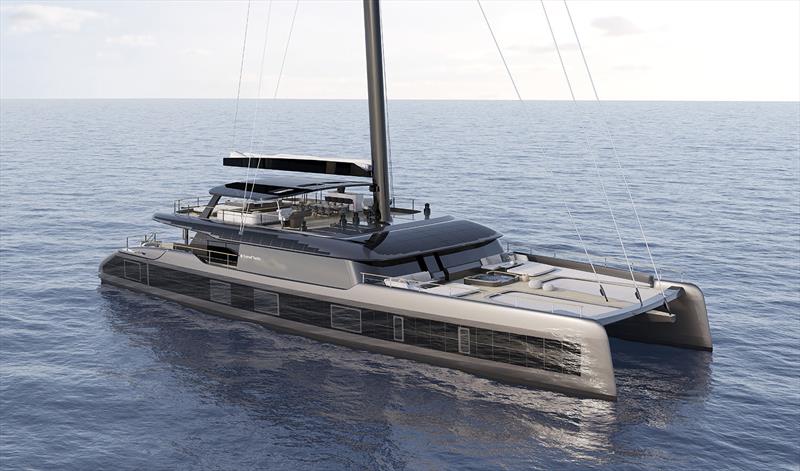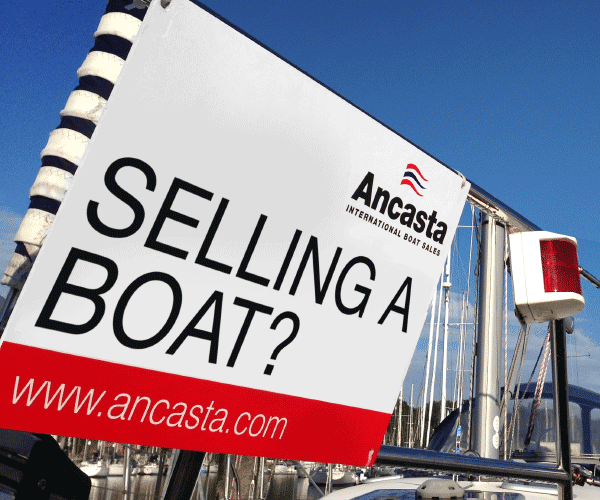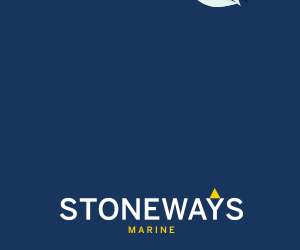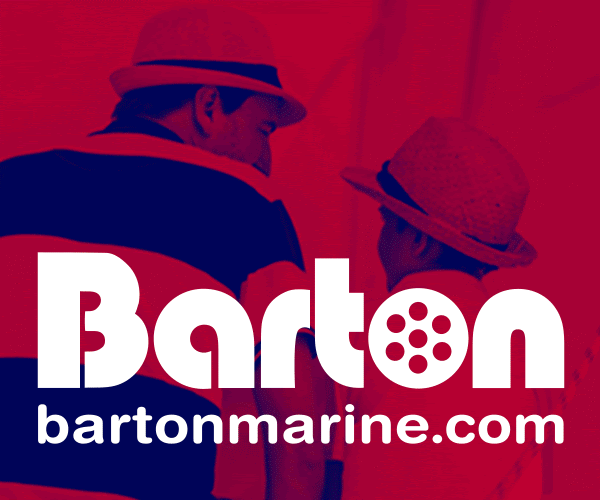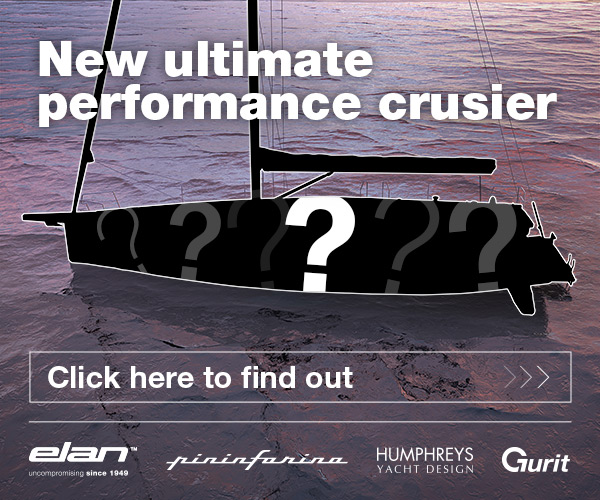Going big. Going bold. Going in style (and certainly going green)
by John Curnow, Global Editor, SailWorldCruising.com 5 Sep 13:00 UTC
Sunreef 43m Eco Superyacht © Sunreef Yachts
Hilariously, as a conversation about colour, boating and green itself are not usually good bedfellows. Then again, we talk about greenies coming over the deck, so go figure…
A far-reaching conversation with Simon Turner, Sunreef’s Global Sales Director (that started at Sanctuary Cove in May, and concluded recently) has given us much to write about, especially with the Cannes Yachting Festival upon us. To say that I have enjoyed it is like suggesting I won’t eat boysenberry ice-cream at every opportunity. It allowed us to do everything from savour the moments on the water we all love, to crystal ball gazing and pondering all things boating.
For this alone I am truly indebted. Thanks Simon.
He was also kind enough to put some context into our earlier discussions and then we chatted some more to answer questions I had developed. In essence, this editorial is sort of in two halves, and it is by no means short. So get the bottle, for a glass will not do, and settle in for the ride. This is fun.
So just what are we talking about?
Turner opened by stating, “In a fast-warming world with an ever-increasing consciousness for sustainability and environmental preservation, we are going to see the re-emergence and even dominance of sailing yachts around the world.
“The sun and the moon are the sources of sustainable energy in that they create the solar energy, wind and tidal power that yachts can use to harness energy with the end goal of ending the reliance on fossil fuels. The goal has to be energy autonomous yachts, and in sailing yachts we are much closer to this goal than most people realise.
“Sunreef has recently sold two 43 metre (140ft) sailing yachts that will utilise the most advanced green technology in the world to enable them to operate for weeks at a time and even longer, without the use of any fossil fuels. The primary energy source is the wind which has been used for millennia, but with new technology (sails and rigging) we are able to harness this in a far more effective way.”
“Solar panels, uniquely embedded into the hull, superstructure and mast provide enough energy to not only power the ‘hotel loads’ (air conditioning, AV, fridges, electronics etc), but also for longer periods for propulsion when there is no wind. When there is wind, the propellors generate significant energy through hydro-regeneration (the propellor rotating in reverse generating electricity which is stored in the batteries).”
See the yacht from every angle: Sunreef Eco Yachts video
“New technology and opportunity abounds. Battery technology is becoming safer and more efficient. Sunreef produces its own batteries, which are smaller, lighter and more safely packaged than most used elsewhere. The yachts are future-proofed by enabling the batteries to be easily and cost effectively replaced in the future as new battery types become available.”
“These batteries, and indeed the energy management systems on our yachts, are also capable of receiving charge from hydrogen via fuel-cell technology. As hydrogen becomes more widely available, simple adjustments to our yachts can be made to incorporate it. Sunreef already has a hydrogen project in build and a methanol-to-hydrogen project under R&D.
“Sail technology is also changing. Wing sails, inflatable sails and kites are now all realistic opportunities. All of which will also incorporate solar cell technology.
“New sail and rigging technology also enables simplicity of usage, and removes the need for highly skilled sailing crew. Certainly not perhaps for the sailing purist or racing enthusiasts, but more for the owner who wants to be greener and all-the-while less burdened by the complexities of a sailing yacht.”
Who’s in?
“All of these developments also bring a new type of customer. Sunreef now has regular enquiries from people who have never owned yachts before, because the green technology intrigues and stimulates them, and they wish to be part of a new movement. Young people around the world, many of whom have rejected fossil fuel technology, are tomorrow’s customers for eco-friendly yachts.
“The technology provides opportunities not just for the yacht itself and energy production, but for energy management and consumption reduction. Sunreef Yachts already feature the most efficient air conditioning in the world (the biggest consumer of energy after propulsion), and combined with clever air flow and heat intake reduction, this has a massive impact on energy consumption.”
“The materials used throughout the yacht also provide opportunities with recyclable materials like basalt (fibre from volcanic rock) and bamboo, which can be used to create natural and beautiful interiors that offer far greater levels of sustainability.
“The whole production process cannot be ignored either. The Water Revolution Foundation is pioneering ways to measure and implement energy reduction solutions in both the construction process and the end product – the yacht itself.”
“Sunreef also has enquiries from the charter world for yachts which are not just energy autonomous, but also semi-autonomous in their operation and navigation. This means the yacht can be prevented from entering protected marine parks or ensuring the yacht does not anchor in no anchor zones.
“It will not be very long before boat shows feature yachts where energy autonomy is the normal and hardly a point of discussion, rather than asking about the fuel capacity and range.”
“Over the past five years of sailing my own classic yacht, I would typically use just 50-60 litres of fuel per season, because the sails would always go up, and if there was no wind I’d open a good book! If we stop rushing around so much and slow down, the opportunities for energy autonomy can be utilised immediately.
“I was in Dubai a few weeks ago with the Captain of our 80 foot solar-electric sailing yacht. I asked him when he last started the generator, and his answer was that he turned it over three weeks ago to check all was in order, but for the most part they try not to use it.
“The future is bright, the future is blue and green,” was how Turner closed out.
Back at you!
Sunreef definitely got known in the first place for sailing cats. So it was important to understand where it is all at right now. “It is very much 50/50. I had customers here (Gdansk) yesterday for the whole day to bed down their new 100 power yacht. As we were walking through the yard, you see all the boats that are nearly finished and going in the water, and it really is half and half,” said Turner.
“I think one of the things we’ve seen in the yacht world is that when people get older, they move from sail to power because it’s a bit easier. However, what we’re seeing with our ECO yachts is that when you are on it, the experience is a little bit like a sailboat. This is because you don’t hear the engines and the bow is not out as it tries to get on the plane. You’re just cruising along, quite silently, just like a sailing vessel.”
So is the line between power and sail blending? Are buyers getting older? Are there plenty of first-time sailors getting involved? Well, quite possibly, but not exclusively. I mean sailing is green, and also silent. Yachts (mono sailing variety) always behave better under sail than power, and it seems for a very large percentage of the new buyer market, pace is not the overarching thought.
In fact, the opposite seems to be true, with 10-12 the desired pace. At least that all pervading spray is not an issue at this point, nor is spilling the drinks unnecessarily with all the slamming and bouncing.
By way of example, Sunreef’s first 100 Power Eco has been sold to an 84-year-old. It’s his first boat, and the thing he really wants is that silent experience. Says a lot doesn’t it. Many of the things we have all enjoyed for ages under sail are now very much sought after, and with sail handling technology still advancing, perhaps soon, the full swing back to sail could well arrive, especially if you can go virtually head-to-wind under stored energy.
Sails deployed and trimmed to the correct angle, then furled once more with screw propulsion added in when required, is not that much of a strange notion. Just take in how much the autopilots do in a current IMOCA. Add in AI for learning, and its Aldous Huxley all the way. Sailing for idiots, or opening the market to those who did not grow up around the sea? I know which theorem I subscribe to.
Hey. Let’s face it. I am happy at 10 or 60 knots, and for now I’ll have to be happy with making 30 under sail. If Sir Russell and the gang, or any of the AC mob ever want to change that, then just call. But yes, doing 60+ takes brutal horsepower, and it goes up with LOA and displacement, no matter the principle driving factor.
Delivering on a plan
Back to Sunreef, and just as so much has moved on with who buys boats now, so too have the production scenarios. The original plant is a throwback to the Lech Walesa era, and is actually listed. It is not the easiest to operate in, or maintain. The company’s 60 to 80s get made here, and then the larger vessels are at a new (just three years old), purpose-built facility elsewhere in Gdansk.
The new UAE expansion will come online soon, with moulds being made right now. It’s all about achieving a genuinely global presence, and then serving markets from a geographically suitable locale, as well as building close to the buyer so that they can access it during build that much more easily.
The new Gdansk plant is used for superyachts, and each one has its own building. There is a 49 metre in build now, and two 43s, as well. It’s all very clean, which is just what the new UAE facility is, and both have room for more expansion as time goes by.
“With the UAE, it’s a little bit like if you are abroad and you go into your embassy; you should feel like it is home. This is our concept with our shipyards. They look, feel, and are run by Poles in a Polish manner. Clean buildings, and robots working, with our craftspeople making a Sunreef, well, a Sunreef. The UAE is a great port to ship from too, with ships going East and West all the time,” said Turner.
So the notion was that Sunreef typically had a high percentage of new-to-boating buyers. Is this still the case? “I think it’s probably correct. I haven’t really studied the data, but it is a great question, and often they are going into very large craft, too. I do think a lot of people who are new to boating want luxury, which is exactly where we’re at.”
“We’re not performance sailboats; we’re not lightweight boats; we’re not fast boats. We are luxury apartments on the sea. I think it’s easier for new boaties to kind of go into this level because they want the comfort, and they want the service on board. They don’t want to be heeled over at 30 degrees getting wet, you know, all that kind of stuff.
“It’s such an interesting question and I think that if you are new to yachting there are so many directions you can go in from the start and some of them might scare you. For instance, if you’re going to go into some kind of performance yacht, it’s going to be a challenge for you. A Sunreef is pretty easy in that sense, because whatever you do, you can’t really do anything majorly wrong with the boat. It doesn’t fall over or upset you, and it only attains a certain speed. It makes it easy for you.”
Just how far can you go?
Are Sunreefs being taken further afield? Some brands have a world rally. So then, are we going to see a Sunreef Odyssey? “It is a question we have been pondering. Sometimes I think it is there, but our customers seem to be of a very individualistic nature. We’ve got boats in South America, North America, Fiji, and no less than seven in Auckland right now!”
“Yes they do big distances, and go around the world, but there doesn’t seem to be a kind of coordinated program. I honestly don’t know if we’re ready to do that, but I do know I would love to offer it.” (Did someone say herding cats?)
So what do Sunreef owners want? There definitely seems to be a plan at the heart of it all, and Turner goes to a lot of client meetings. “Every situation is completely different with every client. I use the phrase that no two Sunreefs have gone out there being the same. Simply because there aren’t. They might look a little bit similar from the exterior, but the interiors are completely different. Being a builder of semi-custom yachts, it’s definitely what we do, and what we’re recognised for.”
“There’s a part of us where we’d like it to be less, we’d like them to be more similar because we can build them faster, but customers like to modify and change to suit them and their requirements. Some want a galley up on the main deck to cook with the family, and others want it all tucked away below with the Master Stateroom taking up pride of place.
“Three cabins or six inside the same footprint happens all the time, and it all just highlights that every project is very, very custom by design and nature. Clients often have technical directors and yacht brokers with them and everyone has ideas. It is how we come up with unique vessels, and I really love that aspect.”
Watch the video: Life on and with a Sunreef 70
Just how many do you do?
Custom is fine, but it takes man-hours. They’re not cheap, no matter where in the world you are, especially when you have a distinct quality overlay, and then there is elapsed time. No one has ever re-invented the quality/time/cost matrix, and for good reason.
Presently, Sunreef do 60 boats a year out of the two existing factories. Quite the feat when you look at the bespoke nature of a lot of what they do, the size of vessels, and of course, the ever-increasing LOA of it all. More production in the UAE is bound to help with the 60-80 bracket in the medium term, but the upper end still requires a lot of resource and time to complete.
It is unlikely they’ll make the 100 vessels a year mark, as the market polarises a bit between the two LOA spheres. However, the capacity at two of the three locations means anything is achievable if the market requires it.
Of course, there is no rock you can hide under when it comes to cost of a cat over a monohull. More expensive when it comes to a pen (berth), slip (haul out), often there are two of something, not one, and cat rigging is heavier in gauge by nature. Then again, this is a luxury product, but is it in the minds of Sunreef’s owners?
Turner commented, “Definitely. It’s always been there. I think more so at the smaller boat lengths. Probably because that kind of customer has other opportunities to evaluate. The counter conversation to it is that is always about stability, and this is where cats shine.”
“By way of explanation, a few weeks ago I was in the South of France with the owner of a Sunreef 80 sailing cat. He’d spent most of his time in Turkey, not really going too far. Then they did a big cruise, and came to Cannes. When they arrived, they couldn’t get into port because everything was full. So they anchored out. After three days he called me and said, ‘I’m never going in port again. This is fantastic.’ He loved it.”
There are three things at play here. One is stability, then the sheer displacement of a Sunreef means small waves or wake is not going to affect it one iota, and finally, as you have a huge platform between the hulls, you can take a significant tender with you (sometimes up to a mighty 1.2 metric tonnes), and subsequently, small chop is not an issue when going ashore. Said platform keeps the tender well away from the water when under way, and also becomes a huge beach club at rest, so that’s two added bonuses.
Turner added, “A lot of our owners don’t have a permanent berth anywhere. If they don’t do the winter season, they just park the boat, but in summer they really cruise around, do big distances, and anchor a lot. For the customer that wants to be in the marina every time in the greatest place, there’s no question that it’s more of a challenge.
“We’re also seeing more people on the bigger boats tow and/or utilise chase boats. If they’re doing the Med or islands somewhere this makes great sense. We have one customer with a Sunreef 80, and he has an Axopar 37 that they use in this fashion. Very practical and sensible.”
Ultimately, it all goes to highlight that the usage of the tender arrangement is just as unique as the usage of the boats, which is just as unique as the customers that come to Sunreef in the first place.
State of play (as in the market right now)
Clearly, Sunreefs are being played with, but what does the company’s crystal ball have to say? “We are ahead of sales on last year (and the year before BTW), which in itself was an incredible 12 months by anyone’s standards. We saw a dip in the early months of 2023, as inflation, ongoing wars, and all the other calamities created uncertainty, but the recovery in the last few months is spectacular. I think we have sold 24 boats in the last two months alone,” stated Turner.
If you consider that a 60-footer is say six to eight months in build, and a 100-footer is more like 16-18, then this is a lot of people making serious commitments to their lifestyle moving forward. Don’t forget, there is also a queue to get going in the first place…
Interestingly, upon signing, one of the first things to occur is the ordering of engines, which goes a long way to explaining the supply issues of Diesels right now.
All Sunreef sailing cats are CatA, and will remain so given the locales owners go to with them. Interestingly, the new line of Ultima powercats coming out of the UAE are to be built under CatB, as a sign of some owners not looking to go that far from home. It will also significantly shorten up the production time, lower the displacement, and provide for more open spaces.
What was once say six months in build should come down to just three (Ultima 55). This does not affect sailing cats per se, but it may free resources up to be applied to sailing cats, and thereby assist in lowering lead times. Interestingly, you do get the feeling that there is more to be said about the sailing cat space, but for now the lips seemed to be sealed…
In terms of build quality (code for reliability and longevity), Turner offered this customer’s take on it all. “When I was in Miami in February, I was speaking to a guy that’s owned a sailing Sunreef 74 for 12 years. He charters the boat and he said, ‘I’m never selling this boat. It just prints money for me.’ His words, not mine.
“The boat has stayed so solid for him, requiring minimal maintenance, works a full charter season (Gulf of Mexico to the Caribbean), and he has a fantastic lifestyle to go along with it. Something like 80% of the boats we build go into some form of commercial operation. Sometimes it just to offset costs, but for others it’s a pure business.”
Blue and green should never be seen… (…without another colour in between)
Well, it seems like we can throw that old chestnut out, like so many others we have dispelled throughout the course of this ditty. “Just yesterday I walked around the yard with clients for the first time in a month or so, due to travel, and I saw solar panels everywhere on our Eco boats. The market just continues to go that way, and I’d say more than half of our enquiries now are for Eco boats. We have 60, 70, 80 Eco sailing cats on display at the Cannes Yachting Festival. We have 500 pre-book viewings already. We’re basically full.
“People are amazingly aware that if they don’t book the appointment in advance, they might not get onboard. The Eco side is just incredible, and the level of knowledge has increased nearly as dramatically. The questions are now much more sophisticated. People are going slower, as such, and people are going back to realising that wind is an essential part of the eco matrix.”
Here’s another video: The Sunreef Eco 80
In closing, Turner said, “You take solar, hydro regeneration and wind power, and you end up with an amazing yacht that needs to use little or no Diesel whatsoever. We’ve led the way, and it is what we’ve been pushing, but I would also say the market is more than responding!”
Sounds like Sunreef Zero is just the beginning…
OK. We have stories, lessons, inspirations and history to regale yourself with. Please use the search window at the top of the home page if you are after something specific, as only the latest news appears on the website as you scroll down. We enjoy bringing you the best stories from all over the globe.
If you want to see what is happening in the other hemisphere, go to the top of the SailWorldCruising home page and the drag down menu on the right, select the other half of the globe and, voila, it’s all there for you.
Finally, stay safe, and let’s see where it all goes now,
John Curnow
Global Editor, SailWorldCruising.com
Credit: Source link

